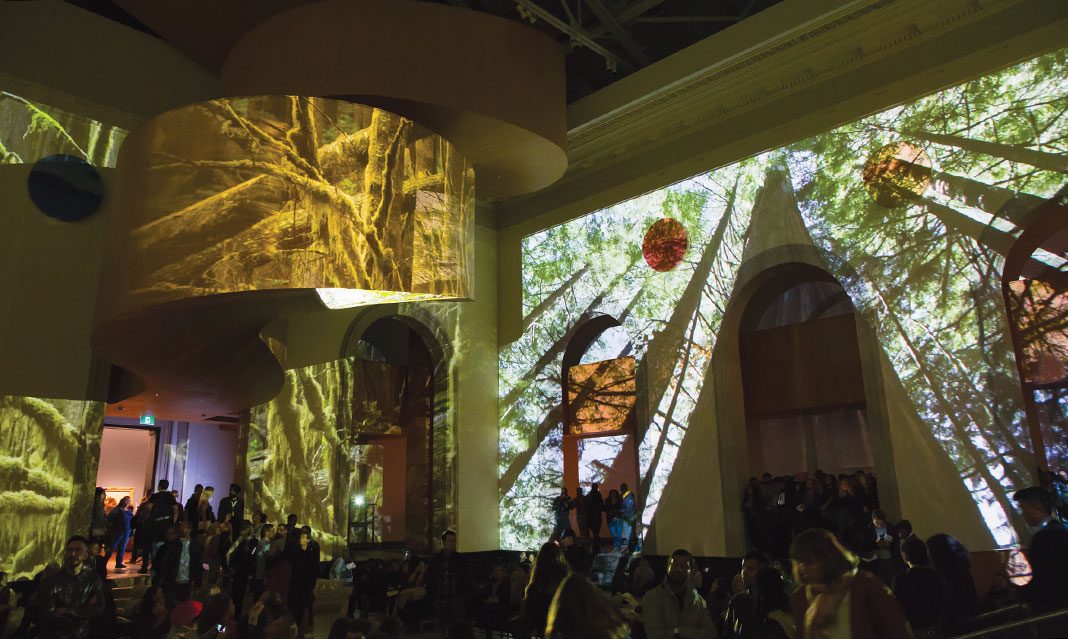The AGO is currently running an exhibition called Anthropocene: The Human Epoch. This exhibit features work by Canadian artists Edward Burtnsky, Nicholas de Pencier, and Jennifer Baichwell. Each artist went to various locations in the world that have been affected by human involvement either for profit or industrialism. They took aerial photographs which were printed onto ink-jets thus giving each photograph a surreal, beautiful look. The exhibit features an app called AVARA which allows for you to watch AR (Augmented Reality) footage of certain places or animals, such as a rhinoceros without horns or the largest burning of ivory, to create an impression of how people are twisting the natural ecosystem, and to contextualize the true feeling of the place they filmed. On the exhibit’s website, the artists describe it as “not wanting to be accusatory.” Their aim is to merely show how humans have changed how the natural world works as this is a highly contentious issue in these global times.
There are images of men walking through rubbish dumps in Kenya, surrounded by dogs. Images of a coral reef that has been bleached and destroyed. Some images invoke how humans are progressing in terms of technology yet are destroying natural landmarks to do so. Each image is particularly striking. It is beautiful but in a truly evil way. It shows how mankind is destroying the environment, not only for animals but also for ourselves. The exhibit gave advice on how to cut down your carbon footprint. Now keep in mind that when these photographers took these photos and videos, to show the truly devastating impact of globalization, inequality, and overuse of resources, it was long before climate change deniers were back at the forefront of world politics. The current denial of climate change and the risk of rising temperatures combined with animals going extinct or being killed for human gain is quite possibly what makes this exhibit even more devastating and potent. Much of the exhibit is set in Africa thus showing how modern-day Africa has still not recovered from colonialism and how the West still abuses its power, forcing many in third world countries into poverty. In addition, the West’s obsession with ivory has led to many rhinos and elephants being killed, driving them to extinction.
However, there are many images of pollution and depletion of resources in America, Europe, and Canada as well. If anything, it shows how no amount of economic power or leverage in the political world can stop countries from being affected by global warming and their own acts regarding the environment. The images of America are incredibly ugly, yet it is startling to learn that African migrants are still being exploited for cheap labor in the West. All of these strong images provoke so many emotions. The tragic beauty of each image and the videos that accompany it. It leaves one feeling empty inside. Whilst other species work symbiotically and only species not suited for a particular ecosystem destroy it, human actions over time have shown great ignorance and nonchalance towards the environment. It is an observant, objective exhibition which is partially why it is so efficient. It is created to evoke emotions in you. It makes you question your own morals and impact as you quite literally see the destruction of the world.
It will leave you with a hollow feeling. Putting this exhibit into its context, an art gallery in North America where the middle to upper class attend, it is almost commenting as to how we affect the wider world. It brings up the question of whether humans have done anything beneficial. We are driving species to extinction and destroying reefs. We are putting holes inside mountains for transport. The exhibition leaves you questioning: “Have humans benefitted the world at all? Would the ecosystem be better without us? Are we driving ourselves and other species to extinction?”
These are questions that I, someone who likes to pretend to care about the environment but is actually very passive, was forced to think about. Except, I did not pretend. I felt these emotions. Everyone should see it. It will invoke emotions of care and denial.
Anthropocene is one of the most memorable and potent exhibits I have ever been to.



